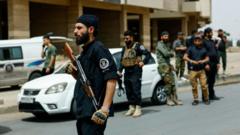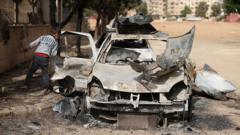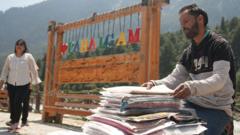As the Syrian landscape grapples with the aftermath of conflict, a tentative alliance forms to address insecurity and ensure communal safety.
**Syria's Path to Stability: Druse Leaders Unite with Government Forces**

**Syria's Path to Stability: Druse Leaders Unite with Government Forces**
In a bid for peace, Druse leaders in Ashrafieh Sahnaya decide to disarm their militias amid rising sectarian tensions.
In a striking display of unity, Druse leaders in Ashrafieh Sahnaya agreed on Friday to overhaul their approach amid escalating sectarian violence. After two days of intense clashes, during which dozens lost their lives, the community's leaders met with government officials under tight security to restore peace. This delegation, escorted by Syrian security forces, signaled a crucial shift from previous resistance to cooperation.
In a solemn meeting held at a local religious hall, officials and Druse elders discussed their shared predicament, emphasizing their collective fate. “We’re all in one ship,” proclaimed Jameel Mudawwar, a prominent government figure, highlighting the necessity of solidarity in facing the upheaval. His calls for unity were met with cautious optimism, given the recent turmoil that had exposed the stumbling grip of new Syrian authorities on security matters.
This recent bloodshed saw the Druse militias, historically protective of their autonomy in the southern sectors of Syria—an area crucial due to its location near Israel—find themselves at a crossroads. The Islamist government had long sought to integrate these militias into the national forces, which many Druse leaders feared would threaten their safety. However, with violence permeating their neighborhoods, local Druse leaders chose a different path. In an unexpected turnaround, they consented to disarmament and an agreement to merge selected fighters into the government military, in return for governmental assurance of accountability for past actions during the clashes.
This newfound collaboration aims to mitigate sectarian hostilities and curtail the cycle of violence that has plagued Syria in recent years. While skepticism remains among some local residents about this sudden shift, the potential for a reinforced security structure through united efforts presents a glimmer of hope amid ongoing challenges in post-civil war Syria.
In a solemn meeting held at a local religious hall, officials and Druse elders discussed their shared predicament, emphasizing their collective fate. “We’re all in one ship,” proclaimed Jameel Mudawwar, a prominent government figure, highlighting the necessity of solidarity in facing the upheaval. His calls for unity were met with cautious optimism, given the recent turmoil that had exposed the stumbling grip of new Syrian authorities on security matters.
This recent bloodshed saw the Druse militias, historically protective of their autonomy in the southern sectors of Syria—an area crucial due to its location near Israel—find themselves at a crossroads. The Islamist government had long sought to integrate these militias into the national forces, which many Druse leaders feared would threaten their safety. However, with violence permeating their neighborhoods, local Druse leaders chose a different path. In an unexpected turnaround, they consented to disarmament and an agreement to merge selected fighters into the government military, in return for governmental assurance of accountability for past actions during the clashes.
This newfound collaboration aims to mitigate sectarian hostilities and curtail the cycle of violence that has plagued Syria in recent years. While skepticism remains among some local residents about this sudden shift, the potential for a reinforced security structure through united efforts presents a glimmer of hope amid ongoing challenges in post-civil war Syria.


















